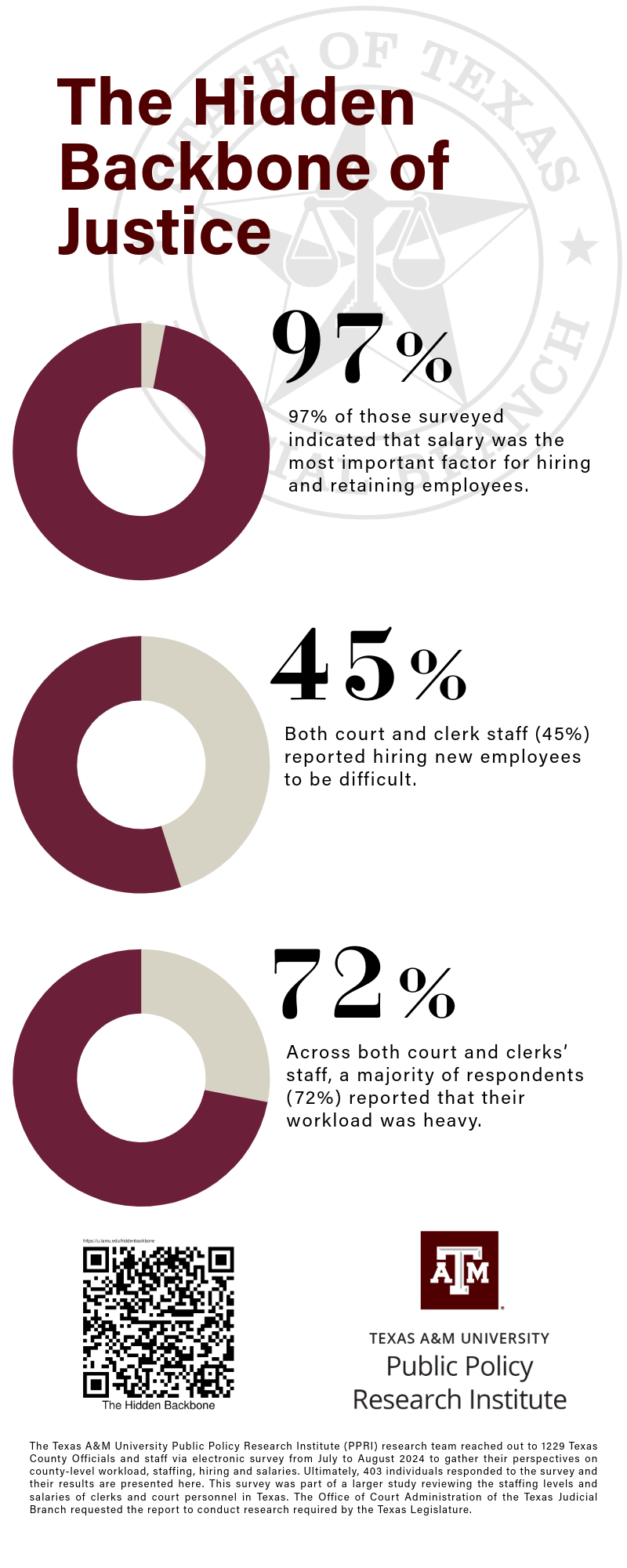TEXAS OFFICE OF COURT ADMINISTRATION COURT PERSONNEL WORKLOAD ANALYSIS
2024
MAKE A DIFFERENCE


“The Hidden Backbone of Justice: Insights into Staffing Levels and Salaries of Court Support Personnel,” was commissioned by the Texas Office of Court Administration (OCA) in response to a legislative rider to assess the staffing levels and salaries of court personnel across Texas. Specifically, the study looks at district courts, statutory county courts, statutory probate courts, and OCA children’s courts. Although not required to participate, District and County Clerks’ Offices were invited to take part in the study, given that staffing levels in courts can impact clerks’ offices, and vice versa.
The study evaluates the perceptions of workload, hiring challenges, retention issues, and compensation disparities. Additionally, it provides data-driven recommendations to optimize staffing levels and salaries to enhance the efficiency and effectiveness of the Texas justice system. In addition to the study, we developed a tool for offices to use to estimate appropriate administrative staffing support for their respective operations. Lastly, recommended appropriate salary ranges were developed for courts and clerks’ office staff.
PURPOSE & SCOPE
The study employed a mixed-methods approach, combining qualitative and quantitative research methods: 1. Clerk and Court Staff Salary Collection: In a first of its kind effort, PPRI collected information on court and clerks staffing levels and salary from 181 of 254 counties gathered through Texas Public Information Act requests. 2. Salary and Staffing Perception Survey of Managers: Surveys were distributed to over 1,200 judges, senior court staff court, and clerks’ office personnel, with 403 completed responses analyzed. 3. Interviews: Thirty-six structured interviews were conducted with staff ranging from court administrators, clerks, judges, court reporters and court coordinators, providing in-depth insights into staffing realities, tasks, and workload. 4. Validation Techniques: Findings from interviews were refined through Delphi Panels and cognitive interviews to ensure relevance and accuracy and used to draft initial staffing tools.
KEY FINDINGS
1. Staffing Perceptions:
o Across both court and clerks’ staff, a majority of respondents (72%) reported that their workload was heavy.
o By contrast, 57% of court staff and 54% of clerk staff reported their current staffing levels were sufficient to address workloads effectively.
o There is significant variation in this perception between urban and rural counties with 55% of urban court staff reporting they did not have sufficient staff and 60% of urban clerk staff reporting the same. Their rural counterparts reported 29% and 43% did not have sufficient staff respectively.
o When interviewed about key staffing needs, judges and court staff reported needing more courts, staffing attorneys, and judges to meet the demand; followed by improved technology integration that can work across agencies and platforms at the county and district levels.
2. Hiring and Retention:
o Both court and clerk staff (45%) reported hiring new employees to be difficult.
o Hiring difficulties were more pronounced in clerks’ offices (54%) compared to court support roles (36%), with most clerk staff having been in their role less than 5 years.
o When surveyed about the most important factors impacting hiring, 97% of those surveyed indicated that salary was the most important factor for hiring and retaining employees.
o Low pay relative to cost of living, lack of qualified applicants, and competition from larger counties or private employers were major barriers to hiring and retaining staff, particularly in rural areas.
o Retention issues were particularly acute in clerks’ offices in rural and counties bordering urban areas where staff regularly leave for offers in neighboring counties or other higher paying positions within their respective county.
o In courts, court reporters were the hardest to hire and retain. On average, court reporters were often the highest paid court position, excluding the judge.
3. Compensation:
o There is profound variation in compensation levels in court and clerk staff across the state with some court and clerk staff being salaried as low as $16,523 per annum in some rural areas.
o Comparatively, coordinator staff in urban areas average a salary of $68,727 per annum.
o Salaries for many court and clerk positions fell below living wage standards. In urban counties, 42% of clerk staff make below the estimated local living wage in their roles. That number reaches as high as 47% in other areas of Texas.
o Clerks report having to hire most staff at entry level wages, and believe their staff are frequently underpaid relative to their workload and responsibilities, contributing to the high rate of turnover in District and Count Clerks’ offices.
4. Workload Challenges:
o Of those surveyed and interviewed, most court and clerk staff reported working more than 40 hours per week, most weeks in order to meet the demands of the job.
o In courts, the caseload had a far lesser impact on the perceived workload than expected. More impactful on staff workload was case type and complexity. Complex civil cases, probate, or criminal trials involving juries and serious criminal matters were more likely to extend a week.
o District and County Clerks are responsible for a wide mandate including maintaining the data and record of the courts in their respective county or district. Often extending beyond clerical duty and into privacy protections, federal reporting requirements, and maintaining and updating case management software and databases.
o Clerks’ offices often faced additional pressures from legislative mandates that require ever increasing granularity and precision in reporting, without accurately accounting for local costs or time. This is compounded by a lack of technology integration or any advanced technology at all, and limited resources for records management and jury administration at the county and district level.
5. Technology and Resources:
o While some counties utilized technology to improve efficiency, inconsistencies in adoption and implementation were noted.
o In some counties, case management systems employed by the courts may be different from the one employed by the clerks.
o Courts and clerks emphasized the need for integrated case management systems and paperless workflows, which can often come with significant costs as well as further technical support from the state to meet ongoing reporting requirements.
Action Items Completed in 2025:
1. Establish an Advisory Panel of members of the Judiciary and an Advisory Panel of County and District Clerks to advise PPRI as we work with OCA to refine the workforce estimation tool. 2. Refine the workforce estimation tool to more accurately reflect the day-to-day activities and time effort needed to complete each activity. 3. Develop an interactive web-based application of the updated workforce estimation tool available for county stakeholders’ use.
Staffing Estimation Calculators:
Clerk Support Personnel Staffing Calculator
Court Support Personnel Staffing Calculator
These resources empower counties and courts to optimize staffing levels and improve operational efficiency. Importantly, PPRI does not collect or store any data from these tools, ensuring privacy and security for all users.











